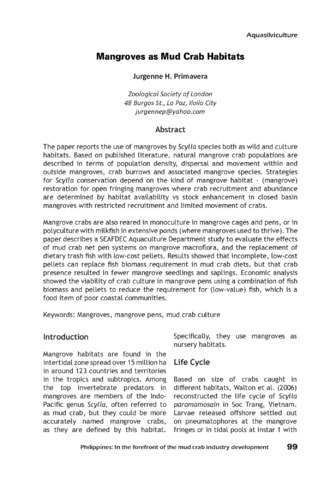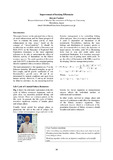Approaches in Rebuilding Sea Urchin and Sea Cucumber Populations in the Philippines
Share
Abstract
Sea urchins and sea cucumbers are among the most valuable and overexploited fishery resources. Culture and release of juvenile Tripneustes gratilla and Holothuria scabra have been undertaken to rebuild depleted populations and provide a supplemental source of income for fishers. In both cases an integrated socioecological approach was used. Studies on factors affecting growth and survival of released juveniles were conducted alongside active participation of local partners in site management and regular monitoring. For T. gratilla, community-based grow-out in sea cages complemented with restocking of protected areas helped in the recovery of a collapsed fishery. Gonad biomass and quality of sea urchins fed with Sargassum were high. These increased the value of the gonads and reproductive output of cultured sea urchins. In the case of H. scabra, release of juveniles in a communal sea ranch resulted in the build-up in density and biomass. Observations of regular mass spawning in the sea ranch established that a viable spawning population was maintained through selective harvesting. Both the sea urchin cage grow-out culture and sea cucumber sea ranch function as reproductive reserves and source of larval supply to adjacent suitable habitats. In addition, wild recruits in the sea ranch and in the vicinity of the sea urchin sea cages indicate that natural recruitment may be enhanced by the high density of conspecific adults. These models have demonstrated that both ecological and economic benefits can be realized through of responsible culture-based management interventions. The development of appropriate governance mechanisms is a critical consideration for sustainability.
Suggested Citation
Meñez, M. A. J. (2016). Approaches in rebuilding sea urchin and sea cucumber populations in the Philippines. In H. Kawamura, T. Iwata, Y. Theparoonrat, N. Manajit, & V. T. Sulit (Eds.), Consolidating the Strategies for Fishery Resources Enhancement in Southeast Asia. Proceedings of the Symposium on Strategy for Fisheries Resources Enhancement in the Southeast Asian Region, Pattaya, Thailand, 27-30 July 2015 (pp. 161-164). Samutprakan, Thailand: Training Department, Southeast Asian Fisheries Development Center.
Subject
resource management  ; Sociological aspects; marine invertebrates
; Sociological aspects; marine invertebrates  ; population density
; population density  ; survival
; survival  ; fish larvae
; fish larvae  ; fishery resources
; fishery resources  ; growth
; growth  ; fishery management
; fishery management  ; protected areas
; protected areas  ; Seaweeds
; Seaweeds  ; juveniles
; juveniles  ; feeding
; feeding  ; stocking (organisms)
; stocking (organisms)  ; feeds
; feeds  ; resource conservation
; resource conservation  ; spawning populations
; spawning populations  ; recruitment
; recruitment  ; stock assessment
; stock assessment  ; larvae
; larvae  ; Habitat; biomass
; Habitat; biomass  ; sustainability
; sustainability  ; depleted stocks
; depleted stocks  ; cage culture
; cage culture  ; stocks
; stocks  ; gonads
; gonads  ; reproduction
; reproduction  ; Philippines; South East Asia; Sargassum; Tripneustes gratilla; Echinoidea; Holothuria scabra; Holothurioidea; cages
; Philippines; South East Asia; Sargassum; Tripneustes gratilla; Echinoidea; Holothuria scabra; Holothurioidea; cages 
 ; Sociological aspects; marine invertebrates
; Sociological aspects; marine invertebrates  ; population density
; population density  ; survival
; survival  ; fish larvae
; fish larvae  ; fishery resources
; fishery resources  ; growth
; growth  ; fishery management
; fishery management  ; protected areas
; protected areas  ; Seaweeds
; Seaweeds  ; juveniles
; juveniles  ; feeding
; feeding  ; stocking (organisms)
; stocking (organisms)  ; feeds
; feeds  ; resource conservation
; resource conservation  ; spawning populations
; spawning populations  ; recruitment
; recruitment  ; stock assessment
; stock assessment  ; larvae
; larvae  ; Habitat; biomass
; Habitat; biomass  ; sustainability
; sustainability  ; depleted stocks
; depleted stocks  ; cage culture
; cage culture  ; stocks
; stocks  ; gonads
; gonads  ; reproduction
; reproduction  ; Philippines; South East Asia; Sargassum; Tripneustes gratilla; Echinoidea; Holothuria scabra; Holothurioidea; cages
; Philippines; South East Asia; Sargassum; Tripneustes gratilla; Echinoidea; Holothuria scabra; Holothurioidea; cages 
Related items
Showing items related by title, author, creator and subject.
-
Mangroves as mud crab habitats
Primavera, Jurgenne (Aquaculture Department, Southeast Asian Fisheries Development Center, 2017)The paper reports the use of mangroves by Scylla species both as wild and culture habitats. Based on published literature, natural mangrove crab populations are described in terms of population density, dispersal and ... -
Improvement of Stocking Efficiencies
Fushimi, Hiroshi (Training Department, Southeast Asian Fisheries Development Center, 2016)This paper focuses on the principal idea or theory of stock enhancement, and the future prospect of 'how to continue the actual activity of stock enhancement in rural areas,' based on the concept of 'Area-Capability'. It ... -
Success of Fish Stock Enhancement and Restocking in Inland Waters of Indonesia
Kartamihardja, Endi Setiadi (Training Department, Southeast Asian Fisheries Development Center, 2016)Stock enhancement and restocking of fish in inland waters of Indonesia has been practiced for a long time. Since 1999, the stock enhancement and restocking practices were based on scientific evidence which include limnological ...




